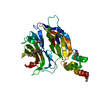+Search query
-Structure paper
| Title | Structure of the HOPS tethering complex, a lysosomal membrane fusion machinery. |
|---|---|
| Journal, issue, pages | Elife, Vol. 11, Year 2022 |
| Publish date | Sep 13, 2022 |
 Authors Authors | Dmitry Shvarev / Jannis Schoppe / Caroline König / Angela Perz / Nadia Füllbrunn / Stephan Kiontke / Lars Langemeyer / Dovile Januliene / Kilian Schnelle / Daniel Kümmel / Florian Fröhlich / Arne Moeller / Christian Ungermann /  |
| PubMed Abstract | Lysosomes are essential for cellular recycling, nutrient signaling, autophagy, and pathogenic bacteria and viruses invasion. Lysosomal fusion is fundamental to cell survival and requires HOPS, a ...Lysosomes are essential for cellular recycling, nutrient signaling, autophagy, and pathogenic bacteria and viruses invasion. Lysosomal fusion is fundamental to cell survival and requires HOPS, a conserved heterohexameric tethering complex. On the membranes to be fused, HOPS binds small membrane-associated GTPases and assembles SNAREs for fusion, but how the complex fulfills its function remained speculative. Here, we used cryo-electron microscopy to reveal the structure of HOPS. Unlike previously reported, significant flexibility of HOPS is confined to its extremities, where GTPase binding occurs. The SNARE-binding module is firmly attached to the core, therefore, ideally positioned between the membranes to catalyze fusion. Our data suggest a model for how HOPS fulfills its dual functionality of tethering and fusion and indicate why it is an essential part of the membrane fusion machinery. |
 External links External links |  Elife / Elife /  PubMed:36098503 / PubMed:36098503 /  PubMed Central PubMed Central |
| Methods | EM (single particle) / X-ray diffraction |
| Resolution | 2.89 - 5.0 Å |
| Structure data | EMDB-14964: HOPS tethering complex from yeast, composite map  EMDB-14965: HOPS tethering complex from yeast, consensus map covering the upper part of the complex  EMDB-14966: HOPS tethering complex from yeast, consensus map covering the bottom part of the complex  EMDB-14967: HOPS tethering complex from yeast, local refinement map of the SNARE-binding module  EMDB-14968: HOPS tethering complex from yeast, local refinement map of the backbone part of the complex  EMDB-14969: HOPS tethering complex from yeast, local refinement map of the bottom part of the complex (Vps18)  EMDB-14970: HOPS tethering complex from yeast, local refinement map of the bottom part of the complex (Vps39)  PDB-7zty: |
| Chemicals |  ChemComp-HOH: |
| Source |
|
 Keywords Keywords | TRANSPORT PROTEIN / tethering / membrane fusion / GTPase effector / HOPS / CYTOSOLIC PROTEIN / tethering complex / lysosome / Rab GTPase / cryo-EM |
 Movie
Movie Controller
Controller Structure viewers
Structure viewers About Yorodumi Papers
About Yorodumi Papers






 chaetomium thermophilum (fungus)
chaetomium thermophilum (fungus)